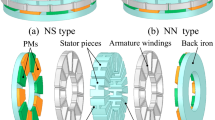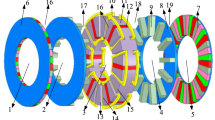Abstract
The objective of this paper is to investigate the mechanism of the three basic elements of electrical machines, namely the source, modulator and filter, acting separately and together from the perspective of the general airgap field modulation theory. Evolution of individual elements on the modulation effects are illustrated by representative topologies, based on which the mutual coupling relation of the basic elements is demonstrated. For instance, the variation of the source or filter has an obvious effect on the modulator such as local saturation, and the principal pole pair combinations of source and filter then the effective harmonic components in modulated airgap field are mutually interrelated etc. In addition, different kinds of modulation behaviors due to the element spatial adjustment are introduced to provide initial design and future topology optimization guidance. It is proven that it is possible to enhance the output characters of a typical magnetic field modulated machine via reasonable selection of element configuration. Electromagnetic performances evolution based on 2-D finite element analysis together with experimental verifications are provided to demonstrate the effectiveness of theoretical analysis.



























Similar content being viewed by others
References
Cheng M, Han P, Du Y, Wen H (2023) General airgap field modulation theory for electrical machines: principles and practice. Wiley, London
Zhou M, Zhang X, Zhao W, Ji J, Hu J (2019) Influence of magnet shape on the cogging torque of a surface-mounted permanent magnet motor. Chin J Elect Eng 5(4):40–50
Wen H, Cheng M, Jiang Y, Tong M, Wang W (2020) Analysis of airgap field modulation principle of flux guides. IEEE Trans Ind Appl 56(5):4758–4768
Sun H, Wang K, Li F, Kong J, Gu Z (2020) Contribution of winding space harmonics to average torque in fractional-slot concentrated permanent magnet machines with equal/unequal teeth. IET Electric Power Appl 14(4):544–551
Zhu X, Hua W, Wang W, Huang W (2019) Analysis of back-EMF in flux-reversal permanent magnet machines by air-gap field modulation theory. IEEE Trans Ind Electron 66(5):3344–3355
Su P, Hua W, Wu Z, Han P, Cheng M (2018) Analysis of the operation principle for rotor-permanent-magnet flux-switching machines. IEEE Trans Ind Electron 65(2):1062–1073
Wen H, Cheng M, Wang W, Zhang G (2021) The modulation behaviors and interchangeability of modulators for electrical machines. IET Electric Power Appl 15(5):542–554
Huang L, Feng J, Guo S, Shi J, Chu W, Zhu ZQ (2017) Analysis of torque production in variable flux reluctance machines. IEEE Trans Energy Convers 32(4):1297–1308
Zhang F, Song Y, Yu S, ** S, Gerada C (2019) Influence of slot combination on performance of brushless doubly fed generator with hybrid rotor. IEEE Trans Magn 55(11):6700406
Hua W, Zhang G, Cheng M (2015) Flux-regulation theories and principles of hybrid-excited flux-switching machines. IEEE Trans Ind Electron 62(9):5359–5369
Zhang J, Jiang Y, Hu X, Xu S (2020) A brushless doubly fed generator based on permanent magnet field modulation. IEEE Trans Ind Electron 67(5):3505–3516
Du Y, **ao F, Hua W, Zhu X, Cheng M, Quan L, Chau KT (2016) Comparison of flux-switching PM motors with different winding configurations using magnetic gearing principle. IEEE Trans Magn 52(5):8201908
Zeng Y, Cheng M, Liu G, Zhao W (2020) Effects of magnet shape on torque capability of surface-mounted permanent magnet machine for servo applications. IEEE Trans Ind Electron 67(4):2977–2990
Zhu X, Hua W, Zhang G (2019) Analysis and reduction of cogging torque for flux-switching permanent magnet machines. IEEE Trans Ind Appl 55(6):5854–5864
Hua W, Zhang H, Cheng M, Meng J, Hou C (2017) An outer-rotor flux-switching permanent-magnet-machine with wedge-shaped magnets for in-wheel light traction. IEEE Trans Ind Electron 64(1):69–80
Huang L, Zhu ZQ, Feng J, Guo S, Shi J (2019) Comparative analysis of variable flux reluctance machines with double- and single-layer concentrated armature windings. IEEE Trans Ind Appl 55(2):1505–1515
Acknowledgements
This work was supported in part by Science and Technology Innovation Program of Hunan Province under Grant 2023JJ40156, and in part by the Key Research and Development Program of Hunan Province under Grant 2023GK2010.
Author information
Authors and Affiliations
Corresponding author
Ethics declarations
Conflict of interest
The corresponding author states that there is no conflict of interest.
Additional information
Publisher's Note
Springer Nature remains neutral with regard to jurisdictional claims in published maps and institutional affiliations.
Rights and permissions
Springer Nature or its licensor (e.g. a society or other partner) holds exclusive rights to this article under a publishing agreement with the author(s) or other rightsholder(s); author self-archiving of the accepted manuscript version of this article is solely governed by the terms of such publishing agreement and applicable law.
About this article
Cite this article
Long, D., Wen, H. & Shuai, Z. Basic Elements Acting Mechanism of Electrical Machines from the Perspective of the Airgap Field Modulation Theory. J. Electr. Eng. Technol. 19, 2425–2436 (2024). https://doi.org/10.1007/s42835-023-01737-z
Received:
Revised:
Accepted:
Published:
Issue Date:
DOI: https://doi.org/10.1007/s42835-023-01737-z




